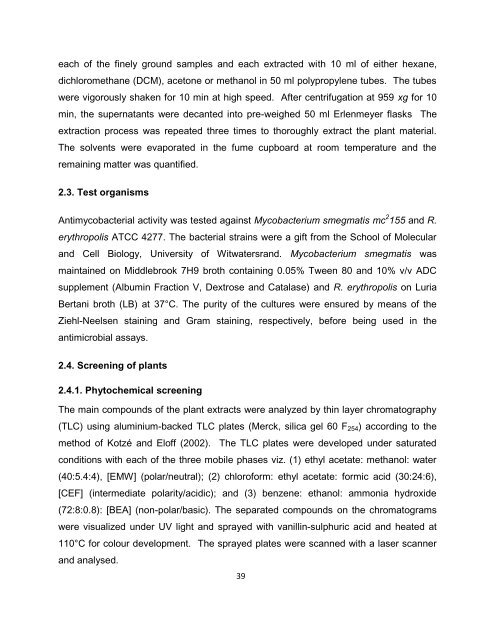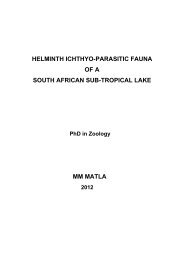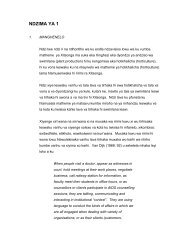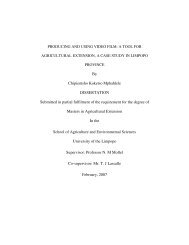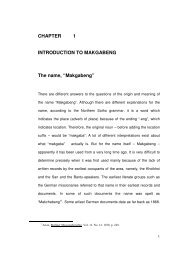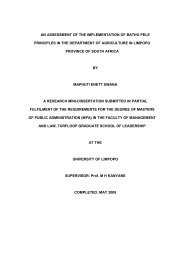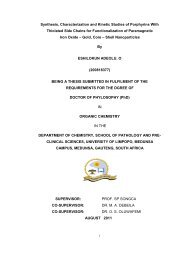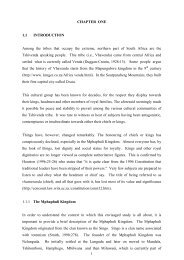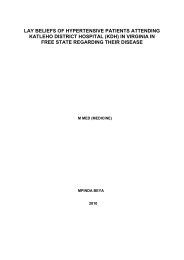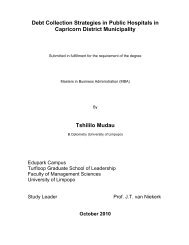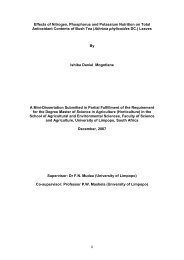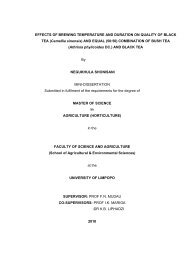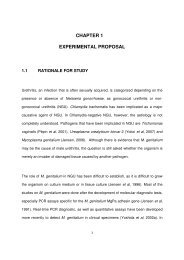Mmushi T MSc (Microbiology).pdf
Mmushi T MSc (Microbiology).pdf
Mmushi T MSc (Microbiology).pdf
Create successful ePaper yourself
Turn your PDF publications into a flip-book with our unique Google optimized e-Paper software.
each of the finely ground samples and each extracted with 10 ml of either hexane,<br />
dichloromethane (DCM), acetone or methanol in 50 ml polypropylene tubes. The tubes<br />
were vigorously shaken for 10 min at high speed. After centrifugation at 959 xg for 10<br />
min, the supernatants were decanted into pre-weighed 50 ml Erlenmeyer flasks The<br />
extraction process was repeated three times to thoroughly extract the plant material.<br />
The solvents were evaporated in the fume cupboard at room temperature and the<br />
remaining matter was quantified.<br />
2.3. Test organisms<br />
Antimycobacterial activity was tested against Mycobacterium smegmatis mc 2 155 and R.<br />
erythropolis ATCC 4277. The bacterial strains were a gift from the School of Molecular<br />
and Cell Biology, University of Witwatersrand. Mycobacterium smegmatis was<br />
maintained on Middlebrook 7H9 broth containing 0.05% Tween 80 and 10% v/v ADC<br />
supplement (Albumin Fraction V, Dextrose and Catalase) and R. erythropolis on Luria<br />
Bertani broth (LB) at 37°C. The purity of the cultures were ensured by means of the<br />
Ziehl-Neelsen staining and Gram staining, respectively, before being used in the<br />
antimicrobial assays.<br />
2.4. Screening of plants<br />
2.4.1. Phytochemical screening<br />
The main compounds of the plant extracts were analyzed by thin layer chromatography<br />
(TLC) using aluminium-backed TLC plates (Merck, silica gel 60 F 254 ) according to the<br />
method of Kotzé and Eloff (2002). The TLC plates were developed under saturated<br />
conditions with each of the three mobile phases viz. (1) ethyl acetate: methanol: water<br />
(40:5.4:4), [EMW] (polar/neutral); (2) chloroform: ethyl acetate: formic acid (30:24:6),<br />
[CEF] (intermediate polarity/acidic); and (3) benzene: ethanol: ammonia hydroxide<br />
(72:8:0.8): [BEA] (non-polar/basic). The separated compounds on the chromatograms<br />
were visualized under UV light and sprayed with vanillin-sulphuric acid and heated at<br />
110°C for colour development. The sprayed plates were scanned with a laser scanner<br />
and analysed.<br />
39


